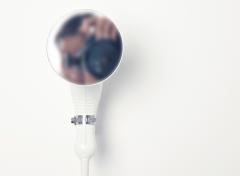waterside contemporary is pleased to present The Antagonist, an exhibition in which the artists, the viewers and the characters trade their places.
Using the quotidian, the historical and the fictional, the artists explore situations in which subject and object become synonymous. In painting, the archive, and the readymade, the works reflect on personal loss, political power and the ego. Each of these inquiries introduces ambivalence to the conventional producer – consumer – content relationship.
Daniel Medina scrutinises systems which govern both the broad and minute aspects of life – from political borders to individual self-regard. His work dissects maps, plans and images in an unfamiliar way, re-assembling them into systems that require viewers to assume alternative frames of reference and dimensions. In New Order, for instance, the world is re-composed as in a puzzle game, without apparent reason, but with inevitable logic.
Medina de-stabilises our pop-experience by setting in motion conflicting sentiments and familiar surfaces. Espejo (Mirror), a sculptural hoax, returns to the viewer his own reflection, but only fleetingly and without certainty. IS/ON, composed of election campaign badges, sets itself in spin until any political attitude loses currency. Once complete, the works place viewer and artists on par, requiring each to select a role – or multiple roles – in the new world-order.
Jamie Shovlin’s Secondaries appears to be a careful presentation of an archive of historical artefacts relating to American history. Close inspection, however, reveals that the sources are rooted as much in fact as in personal memory, that their authenticity is superficial, and that the records are reproductions. Addressing a political era which Shovlin experienced only as a legacy of cultural experiences, the artist assumes authority of historian-curator, employing a pseudo-scientific research method, before revealing that his knowledge is inherited and his perceptions are those of a private citizen. Any reader of this archive is obliged to replicate Shovlin’s own method, taking on multiple points of view at once, and becoming an actor of collective memory.
Sanam Khatibi’s paintings and drawings, while emanating from the world of the fairytale, the infantile and the magical, often depict figures and landscapes in a state of anxiety, hurt and anguish. Through the exploration of how trauma marks everyday experience, Khatibi explores the way that individual experience forms external and collective identity.
Khatibi’s subjects are caught in a duality of power and failure, splendour and fragility. The paintings offer few clues as to the cause of their characters’ plight. Denied an explanation and without a sense of direction, they are to be justified, perhaps along with the viewer and the author – in proclaiming I didn’t feel a thing, as in the title of one of Khatibi’s works which features horse-racing jockeys thrown into the air and detached from the animals, gravity or obstacle. Externalising the reassuring narratives, Khatibi forces the viewer to take on the roles of her subjects, and seek motive and reason on their own.
Extending the casual author - artwork – audience relationship, the artists are at once creators and actors, taking on both heroic and less clear-cut roles. As antagonists, they perform anxieties, fallibility and irrationality. Looking on, we are drawn to take a part in the action too. We realise that we are part of the system we act in, and that Khatibi’s disquiet, Shovlin’s historical process and Medina’s territorial self-reflection are just as much our own.
The Antagonist: Sanam Khatibi, Daniel Medina, Jamie Shovlin
Waterside Contemporary, 2 Clunbury Street, London

Ad
Event has ended
This event ended on Saturday 28th of April 2012
This event ended on Saturday 28th of April 2012
Admission
Free
Free
Location
Waterside Contemporary, 2 Clunbury Street, London
Tags:
Art
User Reviews
mariposa8
Mar 25, 2012
This was a small exhibition and a good one. The fourth of July sequence was really good,contrasting how the day is marked annually with the original event itself. We remember it, but at the same time have become possibly very removed from it too. There is a vibrating mirror that you can look into and it seems to almost erase, or perhaps add multiple possibilities of you. You see several of your own faces, but then it rubs out and starts again. There is an area with paintings of a jockey falling of a horse. No face is revealed. There is something absurd and almost funny about this set of paintings (or was for me). There was a sound bit with the back of peoples´heads one was instructing the other to nod and there was another instruction I didn´t hear.
I liked where the gallery was. It´s new and was next to a laundrette in a small parade of shops on a council estate.
Thanks.
I liked where the gallery was. It´s new and was next to a laundrette in a small parade of shops on a council estate.
Thanks.
